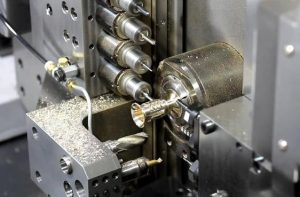What Sets Swiss Machining Apart?
In the realm of precision manufacturing, Swiss machining stands out as a specialized technique renowned for its unique features and advantages. Let's explore what sets Swiss machining apart from conventional machining methods.

Exceptional Precision
Subhead: Sub-Micron Accuracy
Swiss machining delivers exceptional precision, capable of achieving sub-micron tolerances as tight as ±0.0001 inches (0.00254 mm). This level of accuracy is unmatched by traditional machining processes, making Swiss machining ideal for producing intricate components with stringent dimensional requirements.
Subhead: Minimal Runout and Deflection
The design of Swiss machines, with their guide bushings and support for the workpiece close to the cutting tool, minimizes runout and deflection during machining. This ensures consistent dimensional accuracy and surface finish, even when working with small-diameter parts or long, slender components.
High Efficiency and Productivity
Subhead: Simultaneous Machining Operations
Swiss machines excel in multitasking, allowing for simultaneous machining operations on multiple axes. With the ability to perform turning, milling, drilling, and tapping in a single setup, Swiss machining significantly reduces cycle times and increases throughput compared to sequential processes.
Subhead: Reduced Material Waste
The bar-fed nature of Swiss machining minimizes material waste by utilizing long, slender bar stock efficiently. This results in minimal material remnants and scrap, contributing to cost savings and improved material utilization compared to traditional machining methods.
Cost-effectiveness and Scalability
Subhead: Competitive Production Costs
Despite its reputation for precision and complexity, Swiss machining can be cost-effective for high-volume production runs. The efficiency gained from simultaneous machining operations and reduced material waste offsets initial setup costs, making Swiss machining competitive for mass production applications.
Subhead: Scalability for Small to Large Production Runs
Swiss machining offers scalability, catering to the needs of both small-batch and large-volume production runs. From prototyping to full-scale manufacturing, Swiss machines adapt to varying production requirements with ease, ensuring cost-effective production regardless of batch size.
Versatility and Complexity
Subhead: Machining Complex Geometries
Swiss machines excel in machining complex geometries and intricate features with high precision. The sliding headstock and guide bushing support allow for precise machining of long, slender parts and challenging contours, expanding design possibilities and engineering solutions.
Subhead: Wide Range of Materials
Swiss machining accommodates a wide range of materials, including stainless steel, titanium, aluminum, and exotic alloys. From medical implants to aerospace components, Swiss machines handle diverse material properties with precision and consistency, ensuring optimal machining performance across various industries.
Conclusion
In conclusion, Swiss machining stands as a pinnacle of precision and efficiency in the manufacturing industry. With its exceptional precision, high efficiency, and versatility, Swiss machining offers a competitive edge for producing complex components with unparalleled accuracy and consistency. Embracing Swiss machining isn't just a choice; it's a strategic investment in precision engineering and manufacturing excellence, driving innovation and competitiveness in today's dynamic market landscape.
